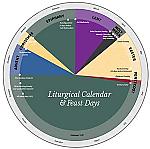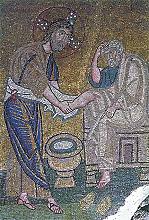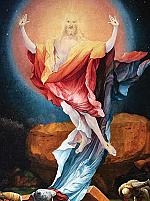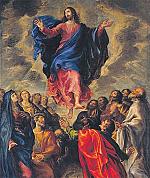Forty days in the desert
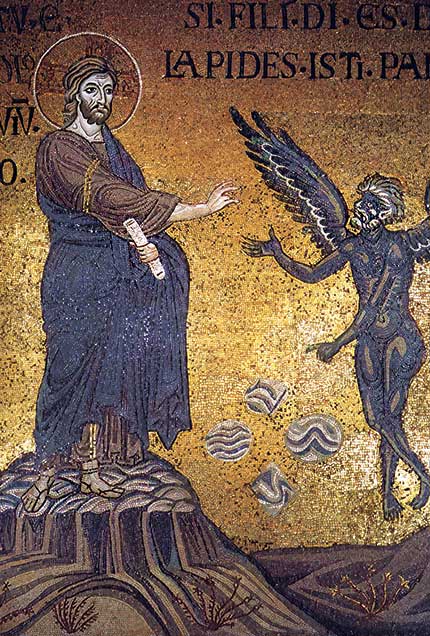
[ABOVE: Christ’s Temptation, Late 12th to Mid 13th Century. Mosaic, Monreale Cathedral, Siciliy—Sibeaster / Public domain, Wikimedia]
In both East and West, Lent is a time of preparation for the celebration of Jesus’s Resurrection and the Easter feast. Perhaps nowhere else is the church’s rhythm between fast and feast more evident than in this season.
Where did it come from?
The ultimate scriptural basis for Lent is the 40 days that the Gospels tell us Jesus spent fasting in the wilderness. While we don’t know exactly when the observance of a period of fasting before Easter began among Christians, it seems to have started very early. This observance was connected to fasting in preparation for baptism—in the early church, baptism normally occurred at Easter—and possibly with a fast kept by Egyptian Christians for 40 days after Epiphany (which, as you will recall, celebrates the Lord’s baptism). The canons of Nicaea refer to a set period of 40 days of fasting before Easter, and a Lenten fast is also referred to in the writings of Athanasius (c. 293–373) and affirmed by Augustine (354–430) and John Chrysostom (d. 407). The word “Lent” is actually derived from an Old English word for spring, lencten; the Latin term was Quadragesima for “fortieth.” A number of languages use a term based on this for the season, while others call it some variation of a term meaning “great fast.”
How is the date determined?
The easy part of this is that the dates of Lent depend on the date of Easter. Here’s the more complicated part.
If you were paying close attention in the previous section, you may have noticed that both Clean Monday and Ash Wednesday are more than 40 calendar days before Easter. In the West the 40 days of Lent run from Ash Wednesday to Holy Saturday, excluding Sundays, as each Sunday is considered to be a “little Easter.” Holy Week technically falls within this period, but in Western practice it is treated almost as a separate season. In the East the 40 days include Sundays and run from Clean Monday through the Saturday before Palm Sunday, known as Lazarus Saturday; Holy Week is explicitly a separate season. (We’ll talk more about this on pages 28–31.)
The Eastern church observes three weeks of “Pre-Lent” in preparation for Lent. Starting on the tenth Sunday (70 days) before Easter is a fast-free week; after the eighth Sunday (56 days) before Easter, Orthodox believers cease to eat meat, but they may still eat dairy products until the seventh Sunday before Easter, which is right before Clean Monday.
The Western church historically observed a similar period of preparation, beginning some Lenten customs on the ninth Sunday before Easter; the ninth, eighth, and seventh Sundays before Easter were called Septuagesima, Sexagesima, and Quinquagesima (from the Latin for seventieth, sixtieth, and fiftieth). This system largely fell out of use in the West during the twentieth century, especially after Vatican II eliminated those names from the Roman Catholic calendar (learn more in our upcoming issue #157).
Theological themes
Among low church Protestants who do observe Lent, the entire season is often seen as a time to contemplate the Passion and death of Christ. In more liturgical churches (whether Protestant, Catholic, or Orthodox), an emphasis on the Passion is reserved for Holy Week, and the Sundays in Lent focus on events in salvation history and in the life of Jesus that point us toward repentance and faith in Christ alone.
In the West the first Sunday after Ash Wednesday is always devoted to Jesus’s temptation in the wilderness; other Sundays across the three-year lectionary discuss themes of covenant and promise, faith and grace, life in the Spirit, the new creation, and the actions that Jesus took as he approached Holy Week. In the East the Sundays of Pre-Lent discuss Zaccheaus, the publican and the pharisee, the prodigal son, the last judgment, and forgiveness (the Sunday directly before Clean Monday). Sundays in Lent focus on commemorating the “Triumph of Orthodoxy” (the final defeat of the iconoclasts in the Byzantine Empire in 843), St. Gregory Palamas, the Veneration of the Cross (which occurs over two Sundays; during the first a large wooden cross is venerated in the church), and St. Mary of Egypt. In the East the final day of Lent is Lazarus Saturday, and it honors Jesus’s raising of Lazarus—which, once every three years, is also the final Lenten reading in the West.
Colors
In the West purple is used in Lent; in the East purple is used on weekends and black on weekdays.
Customs
Many Lenten customs exist around the world, and they vary widely by country and denomination. However, one of the most common practices of Lent across both East and West is fasting and/or abstinence from food. In the East believers normally abstain from meat, fish, eggs, dairy products, wine, and oil. Some of these fasting rules are relaxed on certain days, but no meat or dairy is consumed during the whole of Lent. In the West the most common and traditional act of fasting is to abstain entirely from food on Ash Wednesday (and, during Holy Week, on Good Friday) and to abstain from meat for the duration of Lent. Other foods and beverages commonly avoided include alcohol, caffeine, chocolate, and sweet things in general.
A common nonfood abstinence custom is to “give up” some activity that is interfering with growth in discipleship (in the twenty-first century, many give up social media!) and/or to “take on” an additional devotional practice such as increased Scripture reading or prayer. Giving to the poor is emphasized—especially money that would have otherwise been spent on an activity or entertainment that you have “given up” for Lent—as is performing acts of charity. The idea behind this Lenten abstinence and increased dedication to discipleship is not to earn favor, but to “clear space” for Christ to work in our lives; to grow closer to him; and, through fasting, prayer, and service, to prepare to greet his Resurrection with joy.
In both East and West, increased church attendance is advocated during Lent. We mentioned midweek Pre-sanctified Liturgies for the Orthodox in the last section; many Western churches also hold a midweek prayer or Eucharist service, or a Bible study coupled with a simple supper.
In the West sanctuary decorations become much simpler and sparser. Brass candlesticks may be switched out for wooden ones, and elaborate flower arrangements replaced with plain greenery. The word “alleluia” is not used in the liturgy or in any liturgical music—some churches lead children in “burying the alleluias” (written on pieces of paper) on Shrove Tuesday, to be unearthed again at Easter. Music for services changes too. The “Gloria in excelsis Deo” (a common liturgical song based on the hymn of the shepherds in Luke 2:14) is replaced with penitential music, often the singing of “Kyrie eleison” (Lord have mercy), and the amount of music in the service is reduced or simplified. In some places any crosses in the sanctuary are veiled (though some churches only do this during Holy Week).
In the East “alleluias” are retained and even increased to emphasize the joyous aspects of fasting and prayer. Daily and Sunday services gradually change throughout the season to incorporate more resources from a Lenten liturgical book called the Lenten Tridion. In addition, the amount of Scripture read in services increases, more opportunities exist to prostrate oneself (i.e., pray lying flat on one’s face), and certain Saturdays are devoted to remembering and praying for the departed. The faithful are encouraged to begin or increase devotional readings from Scripture and from the writings of the church fathers.
Fixed feast days that occur during Eastern Lent involve some relaxing of solemnity and fasting rules—by far the most important of these that may fall during Lent is the Annunciation to the Virgin Mary (Luke 1:26–33) on March 25. Western Christians also observe the Annunciation (which frequently also falls during Western Lent) as a feast and relax fasting rules on that day. CH
Some things you can do at home
• Commit to one of the spiritual practices mentioned above—prayer, abstinence from food or entertainment, or giving to the poor.
By Jennifer Woodruff Tait
[Christian History originally published this article in Christian History Issue #156+ in 2025]
Jennifer Woodruff Tait is Senior Editor of CH magazineNext articles
The holiest week of the year
The week between Palm Sunday and Easter has traditionally been considered the holiest week of the church year.
Jennifer Woodruff TaitCelebrating the risen Savior
Jesus’s Resurrection is the event on which everything else about the Christian faith depends.
Jennifer Woodruff TaitAscension
He ascended into heaven and is seated at the right hand of God the Father Almighty.
Jennifer Woodruff TaitSupport us
Christian History Institute (CHI) is a non-profit Pennsylvania corporation founded in 1982. Your donations support the continuation of this ministry
Donate



